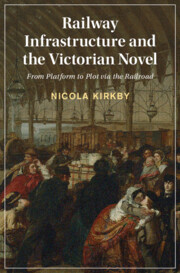
- Coming soon
- Publisher:
- Cambridge University Press
- Expected online publication date:
- August 2025
- Print publication year:
- 2025
- Online ISBN:
- 9781009295598

From 1830 onwards, railway infrastructure and novel infrastructure worked together to set nineteenth-century British society moving in new directions. At the same time, they introduced new periods of relative stasis into everyday life – whether waiting for a train or for the next instalment of a serial – that were keenly felt. Here, Nicola Kirkby maps out the plot mechanisms that drive canonical nineteenth-century fiction by authors including Charles Dickens, Elizabeth Gaskell, Anthony Trollope, George Eliot, Thomas Hardy and E. M. Forster. Her cross-disciplinary approach, as enjoyable to follow as it is thorough, draws logistical challenges of multiplot, serial, and collaborative fiction into dialogue with large-scale public infrastructure. If stations, termini, tracks and tunnels reshaped the way that people moved and met both on and off the rails in the nineteenth century, Kirkby asks, then what new mechanisms did these spaces of encounter, entanglement, and disconnection offer the novel?
 Loading metrics...
Loading metrics...
* Views captured on Cambridge Core between #date#. This data will be updated every 24 hours.
Usage data cannot currently be displayed.
The PDF of this book complies with version 2.1 of the Web Content Accessibility Guidelines (WCAG), covering newer accessibility requirements and improved user experiences and achieves the intermediate (AA) level of WCAG compliance, covering a wider range of accessibility requirements.
Allows you to navigate directly to chapters, sections, or non‐text items through a linked table of contents, reducing the need for extensive scrolling.
Provides an interactive index, letting you go straight to where a term or subject appears in the text without manual searching.
You will encounter all content (including footnotes, captions, etc.) in a clear, sequential flow, making it easier to follow with assistive tools like screen readers.
You get concise descriptions (for images, charts, or media clips), ensuring you do not miss crucial information when visual or audio elements are not accessible.
You get more than just short alt text: you have comprehensive text equivalents, transcripts, captions, or audio descriptions for substantial non‐text content, which is especially helpful for complex visuals or multimedia.
You will still understand key ideas or prompts without relying solely on colour, which is especially helpful if you have colour vision deficiencies.
You gain clarity from ARIA (Accessible Rich Internet Applications) roles and attributes, as they help assistive technologies interpret how each part of the content functions.